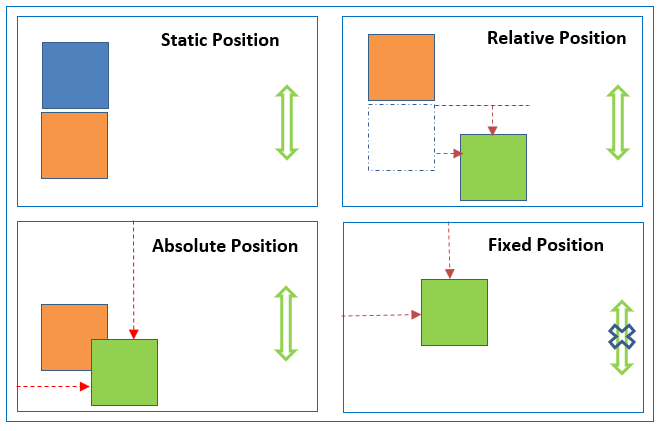- Published on
CSS Positioning Types: How Do They Differ?
- Authors
- Name
- Full Stack Engineer
- @fse_pro

CSS positioning is a crucial aspect of web design that allows you to control the layout and positioning of elements on a webpage. Understanding the different CSS positioning types and how they differ is essential for creating flexible and dynamic layouts. In this article, we will explore the various CSS positioning types and discuss when to use each one.
Introduction to CSS Positioning
CSS provides several positioning types that allow you to control the placement of elements on a webpage. The four main positioning types are:
Static Positioning: This is the default positioning type in CSS. Elements with static positioning are rendered in the normal document flow, and their position cannot be changed using positioning properties.
Relative Positioning: Relative positioning allows you to position an element relative to its normal position in the document flow. You can use the
top,bottom,left, andrightproperties to offset the element from its original position.Absolute Positioning: Absolute positioning allows you to position an element relative to its nearest positioned ancestor. If no positioned ancestor is found, the element is positioned relative to the document body. Absolute positioned elements are taken out of the normal document flow.
Fixed Positioning: Fixed positioning is similar to absolute positioning, but the element is positioned relative to the browser window instead of any ancestor element. Fixed positioned elements remain fixed in their position even when the page is scrolled.
Understanding the Differences
It's essential to understand the differences between these positioning types to make informed decisions when designing web layouts. Let's dive deeper into each positioning type and their use cases.
Static Positioning
Static positioning is the default behavior for all elements in CSS. Elements with static positioning are rendered in the normal document flow and follow the order in which they appear in the HTML markup. Static positioned elements are not affected by the top, bottom, left, or right properties.
Relative Positioning
Relative positioning allows you to position an element relative to its normal position in the document flow. This means you can offset the element from its original position using the top, bottom, left, and right properties. Relative positioned elements still take up space in the document flow, which can affect the positioning of other elements.
Absolute Positioning
Absolute positioning allows you to position an element relative to its nearest positioned ancestor. If no positioned ancestor is found, the element is positioned relative to the document body. Absolute positioned elements are taken out of the normal document flow, which means they do not affect the positioning of other elements. This positioning type is commonly used to create overlays, tooltips, or absolutely positioned elements within a container.
Fixed Positioning
Fixed positioning is similar to absolute positioning, but the element is positioned relative to the browser window instead of any ancestor element. Fixed positioned elements remain fixed in their position even when the page is scrolled. This positioning type is often used for creating fixed navigation bars, sticky headers, or persistent elements that should remain in view as the user scrolls.
Code Samples
Let's take a look at some code samples to understand how these positioning types are implemented in CSS:
Relative Positioning
.relative-container {
position: relative;
}
.relative-element {
position: relative;
top: 20px;
left: 30px;
}
Absolute Positioning
.absolute-container {
position: relative;
}
.absolute-element {
position: absolute;
top: 0;
right: 0;
}
Fixed Positioning
.fixed-element {
position: fixed;
top: 0;
left: 0;
}
Conclusion
To further enhance your knowledge of CSS positioning, here are the top 5 resources you should read or watch:
Positioning Types: How Do They Differ?: An excellent article from CSS-Tricks
CSS-Tricks: CSS Positioning: An in-depth guide to CSS positioning by CSS-Tricks.
MDN Web Docs: CSS Layout - The position Property: Mozilla Developer Network's documentation on the CSS
positionproperty.
Now, armed with a solid understanding of CSS positioning types, you can confidently create versatile and visually appealing web layouts. Happy coding!